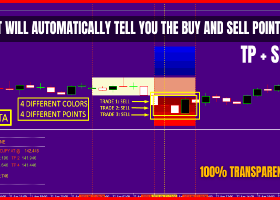
ICHIMOKU CLOUD TRADING STRATEGIES EA MT4/MT5 Settings/Inputs Guide
Ichimoku Expert Advisor Documentation
This Expert Advisor (EA) is based on the Ichimoku Kinko Hyo indicator, leveraging its comprehensive market analysis capabilities to identify optimal entry and exit points. In addition to its core strategy, it includes optional advanced features such as Moving Average filtering on higher timeframes, grid recovery, hedge, martingale strategies, position sizing based on profit, and day and time filters. These features enhance adaptability to various trading environments.
We divide our input sections into two parts. The first part is indicator-related settings, which you can find at the bottom side of the EA inputs. All other settings are common for every EA we make. We call these additional features. You can find the detailed documentation of these settings in this link.
MT4 version is available here Ichimoku Strategies EA MT4
MT5 version is available here Ichimoku Strategies EA MT5
1. Ichimoku Settings
Ichimoku Input Parameters
- ICHIMOKU1_TEXT_1 - Divider text for visual clarity in the input section. (Not important for EA calculation)
- ICHIMOKU1_TEXT - Text label for Ichimoku settings. (Not important for EA calculation)
- ICHIMOKU1_TEXT_2 - Divider text for visual clarity in the input section. (Not important for EA calculation)
- ICHIMOKU_TIMEFRAME - Selects the timeframe for Ichimoku calculation. Default: PERIOD_CURRENT .
- TENKAN_SEN - Sets the period for the Tenkan-sen line. Default: 9 .
- KIJUN_SEN - Sets the period for the Kijun-sen line. Default: 26 .
- SENKOU_SPAN_B - Sets the period for the Senkou Span B line. Default: 52 .
Entry Strategy Options
- ENTRY_STRATEGY1 (Kijun Cross Strategy)
Buys when the price crosses above the Kijun-sen; sells when the price crosses below it. - ENTRY_STRATEGY2 (Kumo Breakout Strategy)
Buys when the price breaks above the Kumo cloud; sells when it breaks below the Kumo cloud. - ENTRY_STRATEGY3 (Chikou Span Confirmation Strategy)
Buys when the Chikou Span confirms bullish momentum; sells when it confirms bearish momentum. - ENTRY_STRATEGY4 (Tenkan-Kijun Cross Strategy)
Buys when the Tenkan-sen crosses above the Kijun-sen; sells when the Tenkan-sen crosses below the Kijun-sen. - ENTRY_STRATEGY5 (Kumo Twist Strategy)
Buys when a bullish Kumo twist occurs; sells when a bearish Kumo twist occurs.
Exit Strategy Options
- EXIT_STRATEGY1 (Kijun Cross Strategy)
Buys exit when the price crosses below the Kijun-sen; sells exit when the price crosses above the Kijun-sen. - EXIT_STRATEGY2 (Kumo Breakout Strategy)
Buys exit when the price breaks below the Kumo cloud; sells exit when it breaks above the Kumo cloud. - EXIT_STRATEGY3 (Chikou Span Confirmation Strategy)
Buys exit when the Chikou Span confirms bearish momentum; sells exit when it confirms bullish momentum. - EXIT_STRATEGY4 (Tenkan-Kijun Cross Strategy)
Buys exit when the Tenkan-sen crosses below the Kijun-sen; sells exit when the Tenkan-sen crosses above the Kijun-sen. - EXIT_STRATEGY5 (Kumo Twist Strategy)
Buys exit when a bearish Kumo twist occurs; sells exit when a bullish Kumo twist occurs. - EXIT_STRATEGY6 (Disable Exit Strategy)
Disables automatic exits.
Note: Only one entry or exit strategy can be active at a time. If you are using grid, hedge, or martingale strategies alongside the base strategy, it is recommended to disable the exit strategy to avoid interfering with these loss recovery mechanisms.
How Different Strategies related to ichimoku works?
1. Kijun Cross Strategy
2. Kumo Breakout Strategy
3. Chikou Span Confirmation Strategy
4. Tenkan-Kijun Cross Strategy (Short-Term)
5. Kumo Twist Strategy
2. Additional Features
Moving Average (MA) Filter on Higher Timeframe
The MA filter enables trades that align with the broader trend based on a higher timeframe moving average:
- Uptrend Condition - Allows buy trades when the close price is above the moving average.
- Downtrend Condition - Allows sell trades when the close price is below the moving average.
Loss Recovery Strategies
There are couple of loss recovery strategies popular in the market. Grid, Hedge and Martingale is most popular among them. In this EA, we have these strategies inbuilt. But only one loss recovery strategy can be active at a time. EA will not load, if we enable more than one loss recovery strategies. There is one important point regarding these strategies, we can not set stoploss if you enable Grid or Hedge strategy. It will close trades earlier and will compromise the purpose of these strategies. All of these strategies are by default disabled.
Grid Recovery Strategy
In a losing position, the EA places additional trades in a grid pattern, averaging down the entry price to capitalize on retracements.
Hedge Strategy
To balance exposure during a losing position, the EA opens opposing trades (hedges), allowing profit potential in countertrend movements.
Martingale Strategy
Increases lot size after a loss on each subsequent signal, aiming for overall profitability.
Position Sizing Based on Profit
This feature adjusts the position size dynamically based on cumulative profit, aiming to optimize gains in favourable conditions. As profit accumulates, the EA increases the position size, allowing for scaled growth and larger potential returns.
Day Filter
Specifies trading days to avoid trading during specific days of the week, aligning with your strategy’s optimal market conditions. You can disable the entire day filter.
Time Filter
Limits trading to specific times, preventing trades during low-liquidity periods or other non-ideal market conditions. You can disable entire time filter.
This ADX-based EA, with versatile entry and exit strategies and advanced risk management features, is a comprehensive tool designed to adapt to various market conditions while offering robust control over trading operations. Use each feature thoughtfully to align with your trading objectives and risk management strategy.


